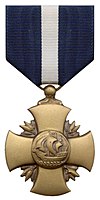Eugene F. Clark
Eugene F. Clark | |
|---|---|
 The Navy Cross | |
| Born | 1911-12 |
| Died | 1998 (aged 86) |
| Allegiance | |
| Service | |
| Rank | |
| Wars | Korean War |
| Awards | Navy Cross |
Commander Eugene F. Clark, USN, was deployed (as a Lieutenant) to the Flying Fish Channel, leading into Inchon. Quickly surveying the area, he and two accompanying South Korean officers Lieutenant Youn Joung (Navy) and Colonel Ke In-Ju (Counterintelligence) landed Yonghung-do Island in Incheon Harbor in advance of the US forces led invasion of Inchon leading to the Battle of Inchon.
Clark and his Korean officers secured the help of the people on the island and using captured junks began to run raids on the North Korean occupied islands of Taebu-do and the harbor fortress of Wolmi-do. He also ran daily mine patrols up and down the channel to ensure the invasion fleet would not be so hampered. Clark was also assisted by Commander Lee Sung Ho, the captain of one of South Korea's four gunboats, at the direction of Admiral Sohn Won-Yil, Chief of Naval Operations, South Korean Navy. He also armed and assisted organized resistance groups hiding out in the hills near Inchon. By doing this he was able to gain valuable information about the layout of troops in the city.
The North Koreans had been slowly infiltrating men onto Yonghung-do for many days and on the night of September 14, the day before the invasion, they struck. Lieutenant Clark and his men bravely fought off the assault by a numerically superior force of North Koreans. However, they were forced to evacuate themselves and all who assisted them to the previously secured lighthouse island of Palmi-do. A day later, at the request of Clark, a battalion of Marines was deployed to take Taebu-do and Yonghung Do. They stormed the islands with vengeance for the brave Koreans who died to help Lieutenant Clark. However, the North Koreans had already murdered over fifty people who had helped Clark and his men but refused to leave the island with them. Lieutenant Clark was awarded the Silver Star for "conspicuous gallantry and intrepidity" in obtaining "vital intelligence information". He was also awarded the Legion of Merit.
Later, in advance of the UN Forces making their way to the Yalu River, Clark, Lieutenant Youn Joung, and 150 South Korean guerillas went island hopping up the west coast of North Korea. After several fierce firefights, Clark was secure and began infiltrating agents. When they reached the Yalu, in late October, they made a shattering discovery. Large numbers of Chinese Communist troops were crossing the Yalu into North Korea. Clark fired this information off to the Far East Command in Tokyo, but they ignored it. Soon faced with a million Chi-Com "volunteers", the UN Forces and General Matthew B. Ridgway were driven back across the 38th Parallel before being able to counterattack. Lieutenant Clark received another Silver Star for that mission.
In his last mission in early 1951, Clark escorted Brigadier General Crawford Sams, one of the Army's top doctors into Chi-Com held Wonsan to investigate a reported outbreak of bubonic plague. Killing the sentries, Clark's team penetrated a small hospital and Brig. Gen. Sams concluded that it was a brand of smallpox. For this, Eugene Clark was awarded the Navy Cross.
Commander Eugene Franklin Clark retired from the United States Navy in 1966, and lived quietly in California and Nevada with his wife Enid until his death in 1998 at 86. He wrote this account for his Korean comrades who fought and died with him on the Flying Fish Islands. However, he never attempted to publish it at all in his lifetime. It wasn't until the summer of 2000, when Thomas Fleming published an account of his exploits that the Clark family remembered the narrative he had written shortly after returning home, along with a DOD clearance to tell the story as he had experienced it. The book is titled: The Secrets of Inchon: The Untold Story of the Most Daring Covert Mission of the Korean War.
A character whom the author admitted was loosely based on Clark, Lieutenant David R. Taylor, USNR, appears in the W.E.B. Griffin novel, Under Fire.
External links
- "Full Text Citations For Award of The Navy Cross to U.S. Navy Personnel Korean War 1950–1953". homeofheroes.com. Retrieved 2010-07-10.
{{cite web}}: Cite has empty unknown parameter:|month=(help) - James A. Field, Jr. "Chapter 7: Back to the Parallel". History of United States Naval Operations: Korea. Naval Historical Center. Retrieved 2008-01-30.
{{cite web}}: Cite has empty unknown parameter:|month=(help) - "The "Blackbeard of Yonghung Do"" (PDF). Naval Historical Center. Retrieved 2008-01-30.
{{cite web}}: Cite has empty unknown parameters:|month=and|coauthors=(help) - "Counterstroke: MacArthur Sells Inchon" (PDF). Naval Historical Center. Retrieved 2008-01-30.
{{cite web}}: Cite has empty unknown parameters:|month=and|coauthors=(help)
